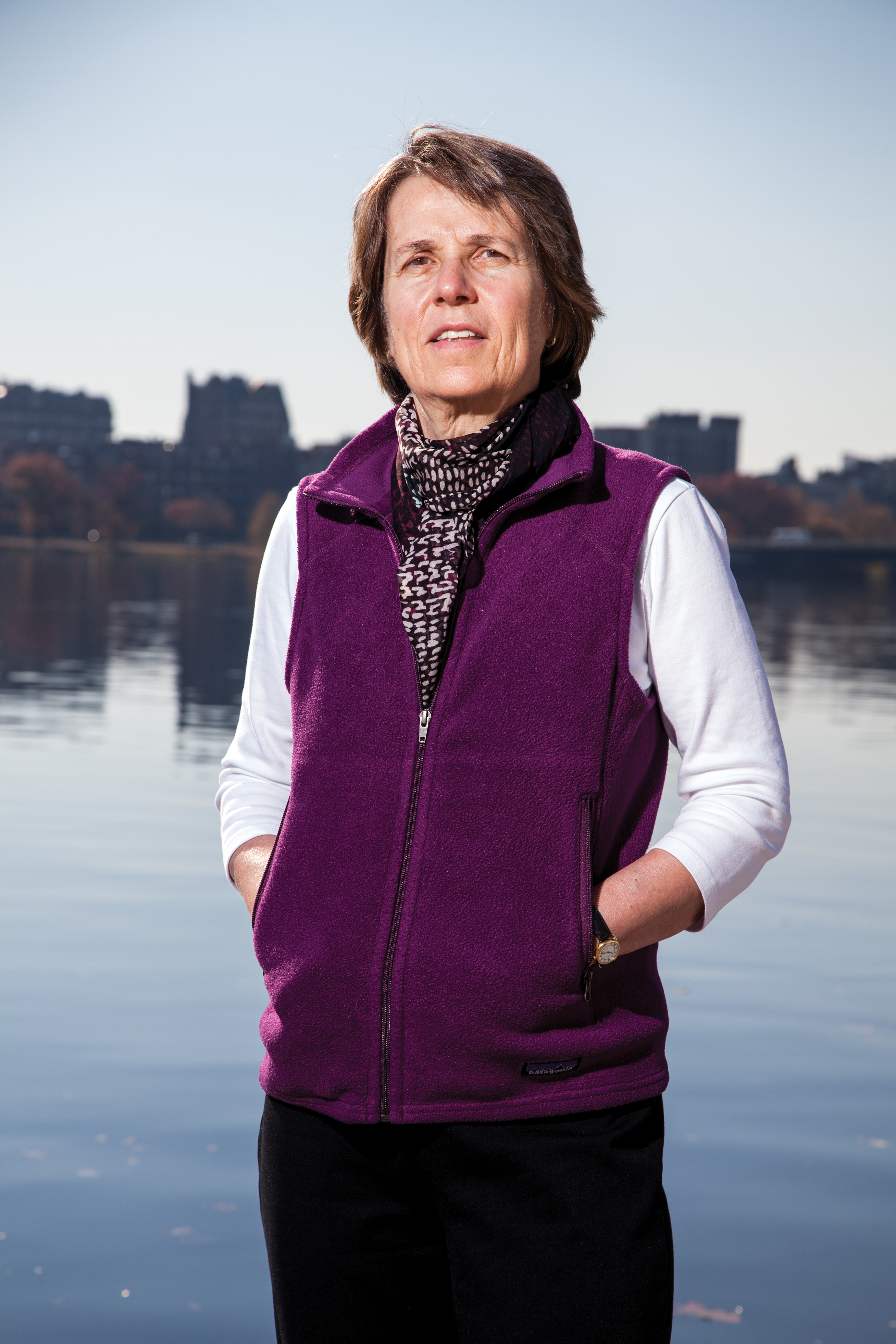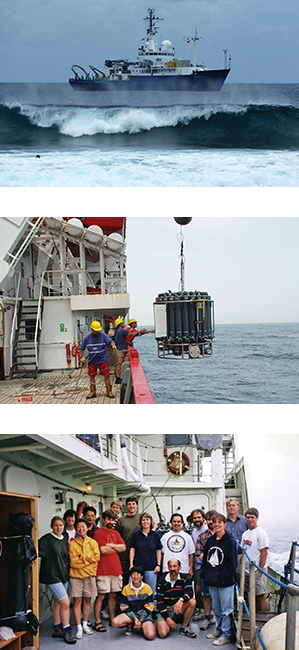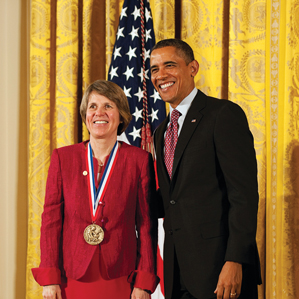Understanding the Ocean’s Smallest Creatures

Sallie (Penny) Chisholm, an ecologist and marine biologist, is known for discovering a type of minuscule ocean-dwelling bacterium that produces up to 10 percent of all the oxygen generated by photosynthesis on Earth each year. Her work is critical to understanding the complexity of marine life and predicting how climate change might ultimately perturb it. Yet until the age of 14, when her family visited the Jersey shore, she had never seen the ocean, let alone contemplated its smallest known photosynthetic creatures. Chisholm grew up during the Baby Boom in remote upper Michigan and spent much of her time skiing. “My hometown didn’t have enough schools,” she recalls, so for most of middle and high school, students attended for just half a day. And whenever there was snow, “the other half-day we skied.”
Her love of aquatic life began on Lake Superior, where she swam in the summers. “It was an idyllic place,” she says. When she moved east in 1965 to attend Skidmore College, she developed a more academic interest in lakes, writing a senior thesis on their chemistry. And as a graduate student in ecology at the State University of New York at Albany, she studied freshwater phytoplankton, tiny photosynthetic organisms that live in sunlit surface waters. Chisholm completed her dissertation on the nutrient uptake of a freshwater species called Euglena. Yet she also realized that when it came to phytoplankton ecology, “the real action was in the ocean,” in part because the U.S. Navy was investing in basic marine science. So in 1974 she accepted a postdoctoral fellowship at the Scripps Institution of Oceanography in California, where, she says, “I learned everything I know about the ocean.”

When she was offered a position at MIT, in 1976, in the Department of Civil Engineering, there were no biologists in the department, she says, and she had no idea what to expect. But she came to appreciate the interdisciplinary mix of researchers interested in the physics, chemistry, and biology of our environment. She also developed close relationships with marine experts through the MIT/Woods Hole Joint Program in Oceanography and Oceanographic Engineering, embarking on research cruises in the Caribbean and the Sargasso Sea. Photographs in her office, several of which show her hale, wind-tousled, and smiling on the decks of ships, provide a glimpse into these early days of her research.
Chisholm is best known for her group’s discovery, in the 1980s, of microbes called Prochlorococcus, the smallest known photosynthetic bacteria in the ocean at less than one micrometer wide. They’re also the most abundant: in a milliliter of seawater, there can be more than 100,000. And because they consume carbon dioxide and release oxygen during photosynthesis, Prochlorococcus make an essential contribution to the balance of these gases on Earth.
Simon Levin, a biologist at Princeton, describes Chisholm’s papers on these microbes as scientific classics. She and her group have been “in the lead in understanding how ocean ecosystems work,” he says, and their discoveries are “crucial in understanding how the oceans will respond to climate change.”
Chisholm herself points out that without oxygen-producing microbes like Prochlorococcus, human beings would probably not exist. Had some ancient marine microörganism not acquired a key mutation some 3.5 billion years ago that allowed it to split water to produce oxygen, she has written, “the evolution of life on Earth would have taken an entirely different trajectory.”
It is remarkable, then, that scientists had such an incomplete picture of these creatures for so long. For years, they believed that the only single-celled organisms carrying out photosynthesis in the oceans were eukaryotes like algae, which are relatively complex cells containing a nucleus, mitochondria, and chloroplasts. The “big discovery,” says Chisholm, came in the late 1970s, when John Waterbury and colleagues at the Woods Hole Oceanographic Institution first identified photosynthetic bacteria called Synechococcus, which are widespread in the ocean. Scientists were surprised that these simple prokaryotes—single-celled organisms that don’t contain a nucleus, mitochondria, or chloroplasts—were capable of photosynthesis.
A decade later, Chisholm and her team homed in on Prochlorococcus, close cousins of Synechococcus that proved to be smaller and more numerous. One of her former postdocs, Robert Olson, had come up with a way to operate a flow cytometer—a sensitive cell-sorting machine then used mainly in medicine—aboard a research vessel at sea. (As a postdoc, he’d set one up in her lab.) In the mid-1980s, several members of her group were using a flow cytometer to study seawater samples in the North Atlantic. Olson, who was still collaborating with Chisholm, noticed tiny particles that emitted a red fluorescent light, suggesting that they contained chlorophyll but did not have the accessory pigments found in Synechococcus, which cause them to fluoresce orange. At first they thought the red light being picked up by their instruments might simply represent electronic noise from the instrument and background from tiny, non-living particles. “It didn’t dawn on us right away that it would be a big deal,” says Chisholm.
But she soon decided to make Prochlorococcus a centerpiece of her research. The team’s paper introducing its findings on these newly discovered bacteria appeared in Nature in 1988.
After one of her graduate students succeeded in isolating the first Prochlorococcus from the Sargasso Sea, Chisholm and her group published a detailed description of the bacteria in 1992, highlighting their cell structure and pigmentation. They also sequenced a portion of the bacteria’s DNA, using the laborious techniques of the day, to assess Prochlorococcus’s relationship to other photosynthetic organisms.

In the late 1990s, Chisholm persuaded the U.S. Department of Energy, which had some of the first-generation sequencing machines, to sequence the DNA of two Prochlorococcus genomes. One, which came from cells collected from a sunlit environment closer to the surface, was found to contain 1,716 genes; the other, from bacteria capable of surviving in dimmer light, lower in the water, had 2,275 genes. Roughly 1,350 of these genes were shared. In a paper published in Nature in 2003, Chisholm described them as including the minimal set of instructions required for photosynthesis. The differences between the genomes, meanwhile, largely reflected the versatility of the bacteria in adapting to environments with different light intensities and different concentrations of nitrogen and trace metals.
Chisholm has now sequenced around 50 strains of Prochlorococcus, which she describes as a stable and highly diverse “federation” of organisms that tend to dwell in the top 200 meters of the ocean. Roughly 1,000 genes define the core of what it means to belong to this species, she says, but each new sequence reveals 80 to 200 entirely new genes. A traditional view might suggest that the various strains are locked in a Darwinian struggle for ocean resources, but Chisholm takes a more sanguine perspective: different strains rise and fall in abundance as nutrient availability and other aspects of the environment shift. The broad range of Prochlorococcus is, she says, “part of what gives them such stability” and allows them, collectively, to play such a central role in the ocean. Indeed, Prochlorococcus is estimated to produce five billion tons of living biomass through photosynthesis each year—nearly as much as its larger cousin Synechococcus. “This carbon is eaten by other small microörganisms, which are in turn eaten by zoöplankton, which in turn are eaten by fish,” says Chisholm. Ultimately, “Prochlorococcus feeds one-tenth of all the creatures in the sea.”

Focusing on the diversity of the species has been an essential part of Chisholm’s work: “I have always believed, as an ecologist, that differences among very similar things have much to tell us about the forces that shape our world,” she says. And this instinct proved prescient in the case of Prochlorococcus. If we had stuck with studying only one strain instead of mining the sea for genetic variants, she says, “we would be so wrong about what Prochlorococcus is like and how they function.”
Chisholm’s lab on the fourth floor of the modest, old-school Building 48 houses an abundance of bacteria. In one room, rows of Prochlorococcus grow in test tubes under varying amounts of black netting. “Some of them can grow at light intensities that would kill the others,” she explains over the whirring of fans. (The fans cool the bacteria—and happen to create a loud wind reminiscent of the seashore.) Elsewhere in the lab, large containers that Chisholm calls “sun machines” simulate dawn and dusk for the bacteria so they “feel like they’re in the ocean,” she says. “They really don’t like it when the lights go off and on suddenly.”
In the oceans, Prochlorococcus coexists not only with other bacteria but also with the viruses that interact with them. In 2003, researchers in the U.K. had discovered that viruses infecting Prochlorococcus themselves carry genes for photosynthesis. In 2004 and 2005, Chisholm’s group showed that during an infection, these viral genes are expressed in bacterial cells while the cells’ own genes for photosynthesis become less active (for reasons that are not yet clear). As viruses move from one bacterial cell to another, snippets of DNA are also shuttled along. This facilitates bacterial evolution—and accelerates it, since genes evolve faster in viruses.
The dance of virus and bacteria includes another mysterious player: small vesicles, or fluid-filled sacs, that float around in the ocean. In 2014, Chisholm’s team discovered that Prochlorococcus sheds lipid droplets containing random bits of DNA, which they first called “blebs.” And while the function of these vesicles is not known, one possibility is that they act as decoys for viruses. They have some of the same surface markings as Prochlorococcus, so the same viruses can attach to them. But because they are not actual cells, the viruses cannot replicate within them and spread, as they otherwise might. Alternatively, since the vesicles contain DNA, RNA, and proteins, they may serve as a mechanism for shuttling chemical information from one cell to another.
Chisholm’s research has earned her many honors, including membership in the National Academy of Sciences and an invitation to the White House from President Obama, who awarded her the National Medal of Science. At MIT, she won the Killian Award in 2014 and was named an Institute Professor in 2015—the two highest honors bestowed on faculty members. But advocacy, public service, and education are also central parts of her work. In addition to wanting to share what she’s learned with the taxpayers who have funded her research, Chisholm is driven by frustration that even educated adults know relatively little about biology, and especially about photosynthesis. She cites a video from the late 1990s in which recent graduates of MIT and Harvard are “handed a seed and a log and asked where the mass of a tree comes from.” The students are shocked to learn that most of it comes from carbon dioxide in the air. MIT does not even have a class devoted entirely to plant biology, she says.
Chisholm’s desire to teach people the basics has led her to lecture widely—and to write children’s books (though she and her husband do not have kids). She and children’s book author and illustrator Molly Bang, a longtime friend, have collaborated on a multiyear project called the Sunlight series, which vividly captures the importance of solar energy to life on Earth. “I thought people would read it to their kids,” she says. “And that way I could actually reach adults.” The series doesn’t skimp on scientific detail. Nor does it shy away from the urgency of climate change; the most recent book describes the origins of fossil fuels and explains how burning them too quickly is probably causing global warming. The goal, however, isn’t to sound alarms but to help people understand how the planet works, Chisholm says.

Despite her own concern about global warming, Chisholm’s research has instilled in her a deep sense of caution about actions that could cause sweeping ecological change. It has made her especially skeptical of human efforts to alter ocean life to draw carbon dioxide out of the air. In 2014, she published an essay in Science warning of the potential unintended consequences of fertilizing the ocean with iron to try to mitigate climate change by stimulating the growth of photosynthetic organisms. Indeed, Chisholm worries that the dynamics of complex ecological systems are nearly impossible to predict. The discovery of Prochlorococcus 30 years ago should remind us of “how little we understand the complexities of marine food webs,” she wrote.
“Microbial ecosystems are what’s running the planet,” Chisholm says, noting their crucial roles in the marine food web and in oxygen production. She and her colleagues hope that their work will allow others to better understand how the biosphere functions to sustain us. “Whether due to human activities such as burning fossil fuels or the inherent properties of the system, which has been evolving for 3.5 billion years, we know that there will be shifts in how this Earth system functions,” she says. “Only if we understand how the system works can we be prepared to deal with those changes.”
To understand how life on Earth could shift in the face of climate change, Levin says, “we need to know who the key players are and what controls their dynamics.” Chisholm’s work contributes directly to this foundation. As the oceans warm, researchers estimate, Prochlorococcus’s numbers may increase by up to 30 percent by the end of the century, with unknown but potentially large consequences for the rest of life on the planet. “These are complex, self-organizing, living systems,” Chisholm says. “I know people want simple answers … but there are none when it comes to this masterpiece of evolutionary fine-tuning.”
Keep Reading
Most Popular
Large language models can do jaw-dropping things. But nobody knows exactly why.
And that's a problem. Figuring it out is one of the biggest scientific puzzles of our time and a crucial step towards controlling more powerful future models.
The problem with plug-in hybrids? Their drivers.
Plug-in hybrids are often sold as a transition to EVs, but new data from Europe shows we’re still underestimating the emissions they produce.
Google DeepMind’s new generative model makes Super Mario–like games from scratch
Genie learns how to control games by watching hours and hours of video. It could help train next-gen robots too.
How scientists traced a mysterious covid case back to six toilets
When wastewater surveillance turns into a hunt for a single infected individual, the ethics get tricky.
Stay connected
Get the latest updates from
MIT Technology Review
Discover special offers, top stories, upcoming events, and more.